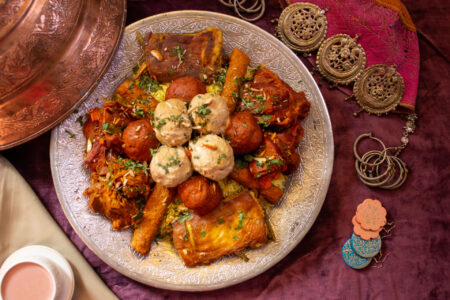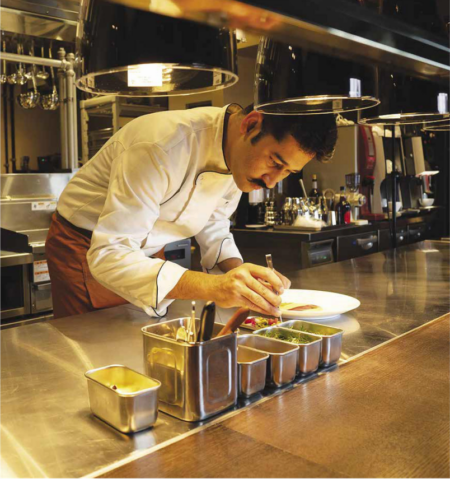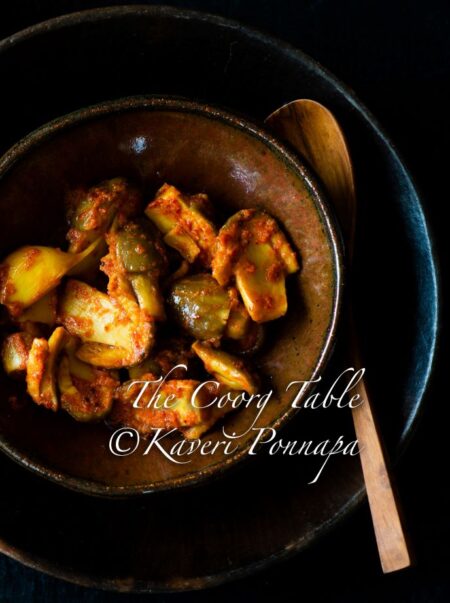The Oberoi Hotels, never renowned for memorable Indian cuisine, have surprised and delighted diners in search of exclusive gastronomic experiences by presenting a trio of outstanding new restaurants —Amaranta, at the Oberoi Gurgaon; Omya, at the Oberoi New Delhi and Zia, at the Oberoi Mumbai — built around contemporary Indian food in a space of less than eight years.
Each restaurant has been meticulously ushered into existence under the mentorship of award-winning Indian Chefs —Alfred Prasad, Vivek Singh and Vineet Bhatia —all of whom have established Indian restaurants overseas to great critical acclaim. At a recent pop-up by Amaranta, hosted by the Oberoi Bengaluru, Kaveri Ponnapa sampled menus created by Executive Sous Chef Tejas Sovani, and got an insight into the latest ideas and techniques driving contemporary Indian fine dining.
There’s a notable harmony and a lack of overcrowding of flavours and elements on my plate. The black cod, single scallop and lobster tail have been handled so delicately, they might have been from a just-landed catch on a seashore, and the accompanying curry of smoked kokum, reduced to a sauce, is rich and deep in flavour. Tiny florets of broccoli mirror a typical vegetable poriyal with some playfulness. This was preceded by a cured Salmon Tartare, the accompanying mustard cream unapologetically, pleasingly, sharp, offset by a sliver or two of dehydrated ginger crisps. If the logic of tasting menus such as this one is to leave you wanting just a little more, I would have gladly opted for another helping of the Spiced Quail Roast and Kurma Gravy served with flaky breads. 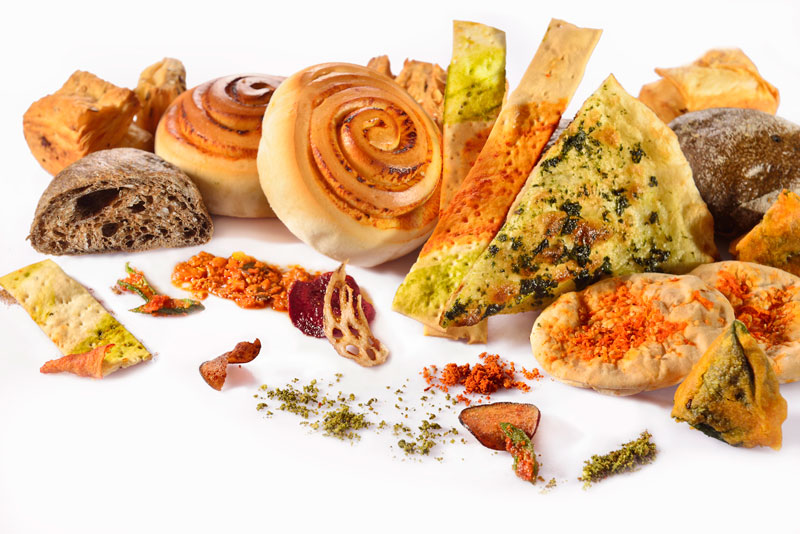
This is regional gastronomy re-interpreted at its best: modern in conception; devoid of clutter; flavour intense; familiar, and yet challenging our sense of recognition and ownership. Chef Tejas Sovani is one of a growing tribe of young chefs in the country unafraid to push the accepted boundaries of what defines Indian cuisine by bringing new techniques and vision to tradition. He shares the defining moments of his career so far: trying to master European cuisine and falling short each time, then working even harder to pursue his dream. Of learning from chefs like Jonay Armas, a disciple of Chef Santi Santamaria, both steeped in the finest Catalan traditions of cooking. Of absorbing the exquisite refinements of skill and presentation at a 16-seater Kaiseki restaurant in Delhi, and later reading a copy of Rene Redzepi’s book, Noma, and finding it completely incomprehensible. But, driven by a desire to learn, applying for, and finally being accepted to ‘stage’ at the world’s most famous restaurant in 2015. When Chef Sovani returned to India to run Amaranta, it was with a fund of experiences which involved foraging, mastering new techniques and thought processes. He was ready to approach traditional food in a very different way.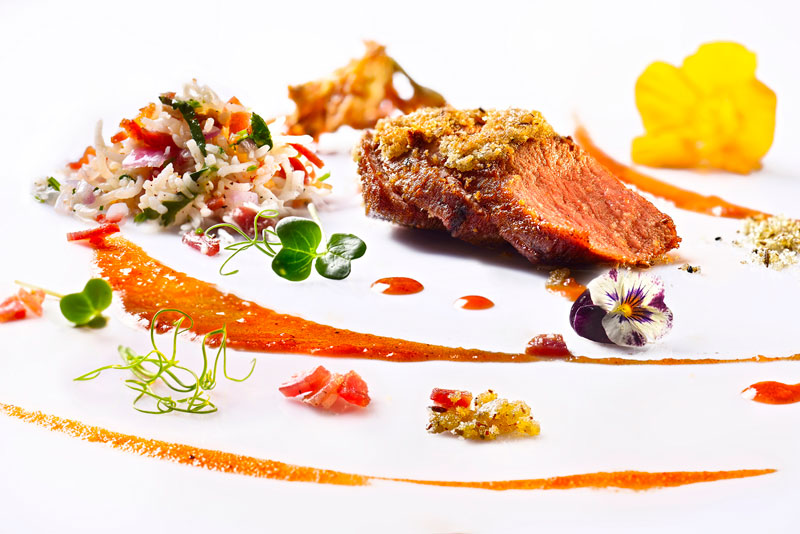 The cuisine at Amaranta is pan-Indian, food without borders in the best sense of the term. Here is a confluence of taste, flavours and ingredients held together by techniques learned under masters. The food on your plate may have been treated to dehydration, fermentation and sous-vide cooking, but ultimately, for Chef Sovani, taste, a sense of familiarity and recognition matter. So, he digs deep into tradition and micro-cuisines. The memorable kokum curry with seafood, for instance, is a take on meen curry dished out with kappa (tapioca) in Kerala’s toddy shops, but lightened up by leaving out the rather weighty kappa. Amaranta has six chefs behind the scenes who have been drawn from small town eateries, chosen for their expertise in highly localized cuisines and specialties. It is Chef Sovani who has to pull the team together and draw on diverse heritages and talents to create new dishes that will stay true to their roots and, at the same time, make an impact on a modern palate. “It took a lot of persuasion to bring these chefs out of their familiar environment, with assurances that their craft would not be misrepresented. Now they are happy with the results,” he says.
The cuisine at Amaranta is pan-Indian, food without borders in the best sense of the term. Here is a confluence of taste, flavours and ingredients held together by techniques learned under masters. The food on your plate may have been treated to dehydration, fermentation and sous-vide cooking, but ultimately, for Chef Sovani, taste, a sense of familiarity and recognition matter. So, he digs deep into tradition and micro-cuisines. The memorable kokum curry with seafood, for instance, is a take on meen curry dished out with kappa (tapioca) in Kerala’s toddy shops, but lightened up by leaving out the rather weighty kappa. Amaranta has six chefs behind the scenes who have been drawn from small town eateries, chosen for their expertise in highly localized cuisines and specialties. It is Chef Sovani who has to pull the team together and draw on diverse heritages and talents to create new dishes that will stay true to their roots and, at the same time, make an impact on a modern palate. “It took a lot of persuasion to bring these chefs out of their familiar environment, with assurances that their craft would not be misrepresented. Now they are happy with the results,” he says.
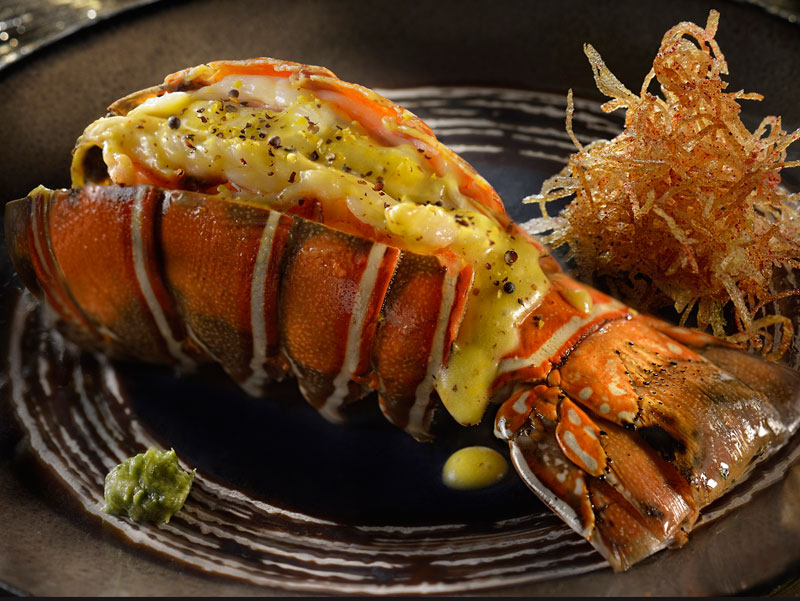 There is an exciting trickle down taking place here. For instance, after an intense discussion, a fellow chef was inspired to create a rendition of the much loved, equally derided, world-famous dish —butter chicken. On the plate you have a pâté of chicken, flattened, poached and cut into ribbons, like pasta. Alongside is a chicken tikka tossed in a reduced gravy, a chicken kofta and finally, the same chicken ribbons dipped in batter, crumbed and fried to a popcorn-like texture. “What you see on your plate does not look anything like butter chicken -but when you taste it, every element of a traditional butter chicken is there,” says Chef Sovani. At Amaranta, you may find yourself eating hollowed-out stalks of heart-of-palm filled with a paste of Jackfruit seeds, mimicking a bone filled with marrow. Chef Sovani is fascinated by the art fermentation and the tremendous potential it has for the menu: “Imagine what it could do for aam ka panna, or kokum sherbet,” he says, adding that these are early days of trial and experimentation, trying to invest the time and attention and find the kind of controlled environment essential for successful fermentation. There are new ideas always waiting their turn with Chef Sovani, although he is careful to gauge the extent of innovation his guests are likely to be receptive to, introducing changes once he feels there is a ready audience. The two meals and varied dishes I experienced can be reduced to a few thoughts: taste; balance; the availability of the best produce and simplicity. These new menus should be of immense interest to wine lovers, as the light, calibrated spicing and plated compositions, compared with dishes typically bathed in heavy sauces, instantly expand the range of wine pairings that become available with a meal.
There is an exciting trickle down taking place here. For instance, after an intense discussion, a fellow chef was inspired to create a rendition of the much loved, equally derided, world-famous dish —butter chicken. On the plate you have a pâté of chicken, flattened, poached and cut into ribbons, like pasta. Alongside is a chicken tikka tossed in a reduced gravy, a chicken kofta and finally, the same chicken ribbons dipped in batter, crumbed and fried to a popcorn-like texture. “What you see on your plate does not look anything like butter chicken -but when you taste it, every element of a traditional butter chicken is there,” says Chef Sovani. At Amaranta, you may find yourself eating hollowed-out stalks of heart-of-palm filled with a paste of Jackfruit seeds, mimicking a bone filled with marrow. Chef Sovani is fascinated by the art fermentation and the tremendous potential it has for the menu: “Imagine what it could do for aam ka panna, or kokum sherbet,” he says, adding that these are early days of trial and experimentation, trying to invest the time and attention and find the kind of controlled environment essential for successful fermentation. There are new ideas always waiting their turn with Chef Sovani, although he is careful to gauge the extent of innovation his guests are likely to be receptive to, introducing changes once he feels there is a ready audience. The two meals and varied dishes I experienced can be reduced to a few thoughts: taste; balance; the availability of the best produce and simplicity. These new menus should be of immense interest to wine lovers, as the light, calibrated spicing and plated compositions, compared with dishes typically bathed in heavy sauces, instantly expand the range of wine pairings that become available with a meal.
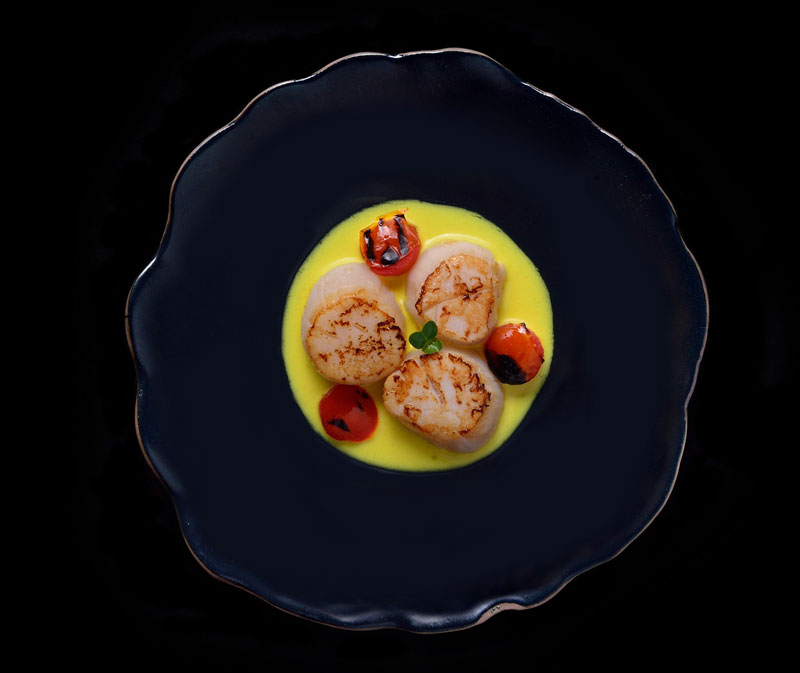
While tasting the Five Spice encrusted loin of lamb, and the densely layered Birbal ki Khichdi that uses quinoa and lentils, inevitably, the thread of our conversation leads to authenticity, a subject of much discussion in the world of food these days. When I mention that a study of a classic Konkani cookbook showed 74% of the recipes examined included at least one crop from the New World, Chef Sovani responds immediately: “New ingredients and spices have always been incorporated into cuisines. Authenticity itself is constantly evolving, what is authentic today will have changed 20 years down the line.” That’s an observation that frees up contemporary Indian cuisine to endless possibilities. Modern interpretations of traditional cuisine in fine dining are no longer just a trend, they are here to stay, part of the changing way we eat and perceive food.
By: Kaveri Ponnapa
Photo Credits: The Oberoi Hotels
This article appeared in Sommelier India Magazine, Volume14: Issue3, July-September 2018 www.sommelierindia.com


